
Ulva prolifera
Branched String Lettuce
Interactions conducted: 26 June 2021, (start time 10:40am PDT)
Brooklyn Creek Estuary, Comox Bay, Strait of Georgia, B.C., Canada.
Tide: 0.3 foot tide 13:41pm PDT (measured at Comox Tidal Station)
Conditions: Clear, no precipitation, wind variable 0 – 5 km/hr, sea smooth, 26˚C.
Phase of Moon: Waning Gibbous (approx. 2 days into this phase at time of interaction); (Previous Phase, Full Moon, 24 June 2021 at 11:39am PDT: Next Phase, Third Quarter, 1 July 2021 at 2:10pm PDT.)
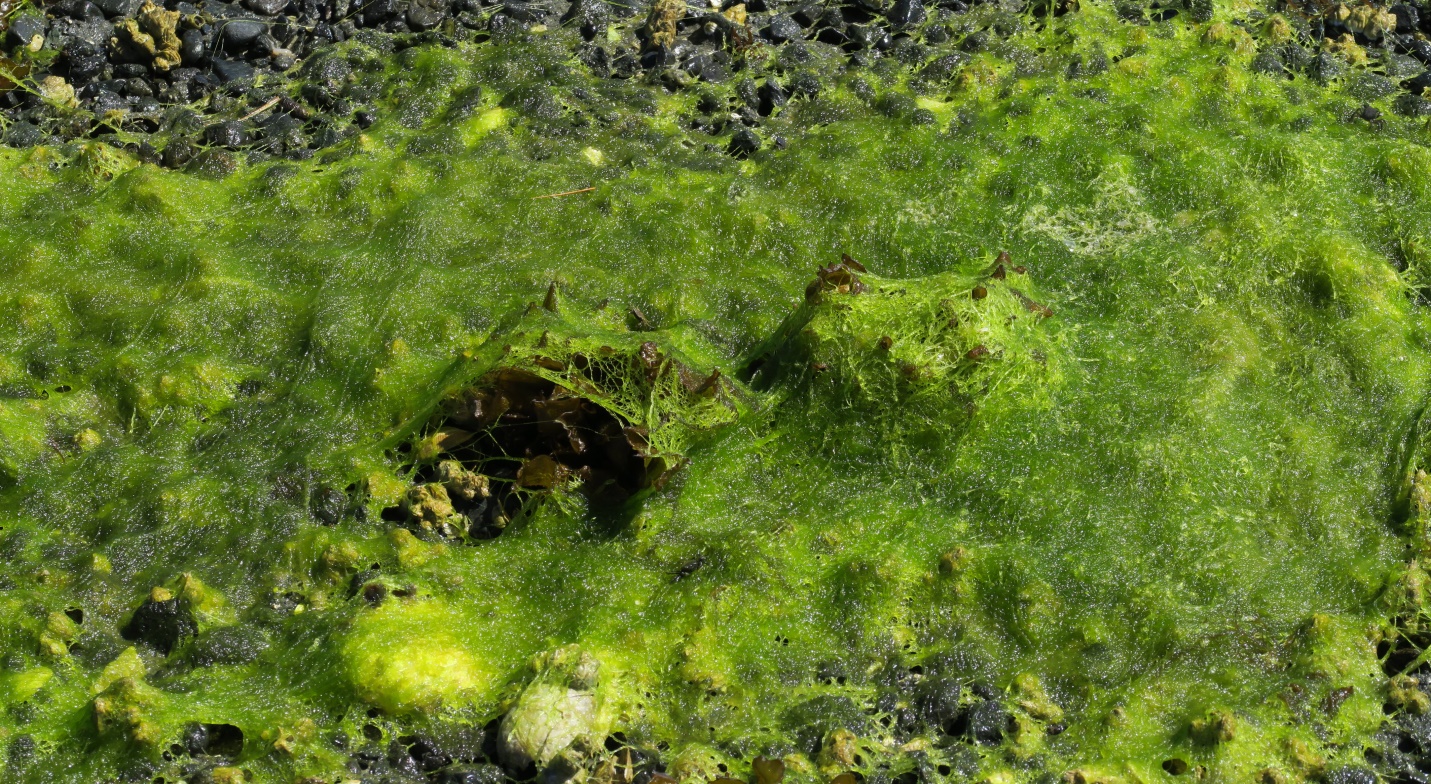
Figure 1: Pictured here is a mat of Ulva prolifera as it rests on a section of gravelly substrate at Comox Bay. It has ‘covered’ a couple of Mastocarpus algae and anything else that is affixed here as it was dropped in place by the receding tide. Comox Bay, Strait of Georgia, B.C., Canada. June 26, 2021. Photo ID 27375 ©Seaweedwhisperings.com
Person 1:
On this beach there were occurrences of this seaweed in varying conditions.
Free floating mats.
They try to keep near the surface for maximum photosynthesis.
Plop down unceremoniously wherever they land when the tide recedes.
If they get tangled in the high intertidal vegetation, they perish, bleach, and become an undifferentiated solid mat.
When live, they have a delicate filamentous appearance.
Bright, bright lime green.
Filaments are translucent.
Unintentionally smother others?
Wandering aimlessly, lost, no agenda.
Most seaweed species are anchored. This one floats above.
No competition to maintain its position.
Perhaps doesn’t need structure in form or movement.
Floating above will often protect it from grazing snails…, the snails tend to prefer being close to ground.
I checked out a patch of stranded and drying String Lettuce.
It was more of a pale lemony color.
I pulled apart some of the mass. Has a feel of cashmere wool – soft.
The filaments have tiny “branches” of spikes all along them, even more giving the appearance of wool.
A large mat of nearly fully dried String Lettuce looked very much a sheepskin rug, it had the inter-tangling of fibres and knit appearance that I associate with such rugs.

Figure 2: A closer view shows the mass of tiny tubes that comprise this seaweeds morphology. Most of the bright green tubes pictured here were around 1 mm in width or less! That they can form mats many meters in size is due to the ‘branching’ nature of the growth. Comox Bay, Strait of Georgia, B.C., Canada. June 26, 2021. Photo ID 27376 ©Seaweedwhisperings.com
Person 2:
Matted groupings of bright lime green translucent threads.
Rafts of algae that enjoy floating in smooth, sheltered waters, AND here you are this summer morning, beached on the gravel and mudflats.
You need to wait this out, but you MUCH prefer to be afloat with the topside of your mat basking in the light, your bottom-side bathing in the cool ocean waters.
Afloat you have a more poof-y indistinct green look.
As you dry out your individual threads become much more evident.
Where you have been beached and stranded you look like the Halloween artificial spider web product that people stretch across doorways as decoration; your matted-ness is stretched over underlying vegetation and rocks and in many places is nearly white rather than green.
Where you are stretched out like this it is at the perimeters of your mass where we can most easily see your individual tiny branches, and how each branch itself branches many times.
All this branching is how you hold together as a mat. There are many places to interlink and not simply slide apart.
The branches are how you become impressive in total size, really impressive, when one considers how tiny each of your threads is on its own.
Some mats were as large as 5 meters long, many were about 2.5 meters.
So many tiny parts combine to form a mat.
Mat likes to be thin.
Tiny threads.
Threads that are tubular.
You are like the “swimming tube” or “noodle” floatation devices people use. That inner hollow core holds air and fills with some water, too. This expands your tube wholly and gives you your remarkable bright green color – it’s a combination of algae and water that creates this.
You are strikingly colored. Later I chose to look up some color samples to ‘name’ your color and I can see that the type of green you often embody when you are vibrantly healthy is in the “neon” range. This has an interesting connection; neon gas needs to be contained and then must have a flow of electricity to light it up, so there are two components at play in creating the one color. Ulva prolifera needs algal tube and ocean water to light it up. Both processes create a striking neon green color.
Maybe you like to mat-up, but you don’t like to form a thick mat; that would mean many layers of Branched String Lettuce would be smothered under each other. You don’t like to be smothered – not at all!
But do you, in fact, smother others…?
I see many bivalve ‘exhalant’ holes that formed first through the mud substrate and then also through the String Lettuce mat atop it as well. I believe any smothering you bring about is an accident of forces beyond your control – that is your innate design of branching prolifically and matting up, and then of course, the dynamic and changeable forces of the tide and currents and wind.
You may like to be broad and thin, but you are also rudderless!
You couldn’t force your way in any particular direction no matter how hard you tried – but you do keep growing and branching, further and further in (mainly) two dimensions.
Is there very little capacity for depth to you yet? Or is your depth within..., contained on the inside of each slender tube?
When stranded higher ashore you look distinctly unwell, Ulva prolifera.
Your matted quality is “rolled” into a loose cord in places, and your lovely green is bleached in varying shades all the way down to off-white. In other places your mat shape is retained, but it is far less attractive than the bright almost luminescent green of your floating rafts. In fact, in several places this alga looks like some kind of litter strung about, like a prominent blemish on the landscape marring the deeper greens of the seagrass and other vegetation in this habitat. This seems to shout out the fact that you do NOT belong ashore!
Stretched out you reminded me also of a hammock – airy webbing strung aloft.
Seagrasses and sea asparagus are draped with you. Your presence is no advantage to them, but there the fates have deposited you and there you will dry and bleach and shrink as time passes.
Here it is clear that each stem is a tube – because when it dries it flattens and broadens and loses its translucency. Larger tubes are a full millimeter wide! Smaller ones are still only a fraction of a millimeter.
Caught.
Stranded.
Cannot break free.
Your own branching nature hooked you here and robbed you of your chance to move back out with the tide to float some more, ah...., to be floating – that is your bliss.
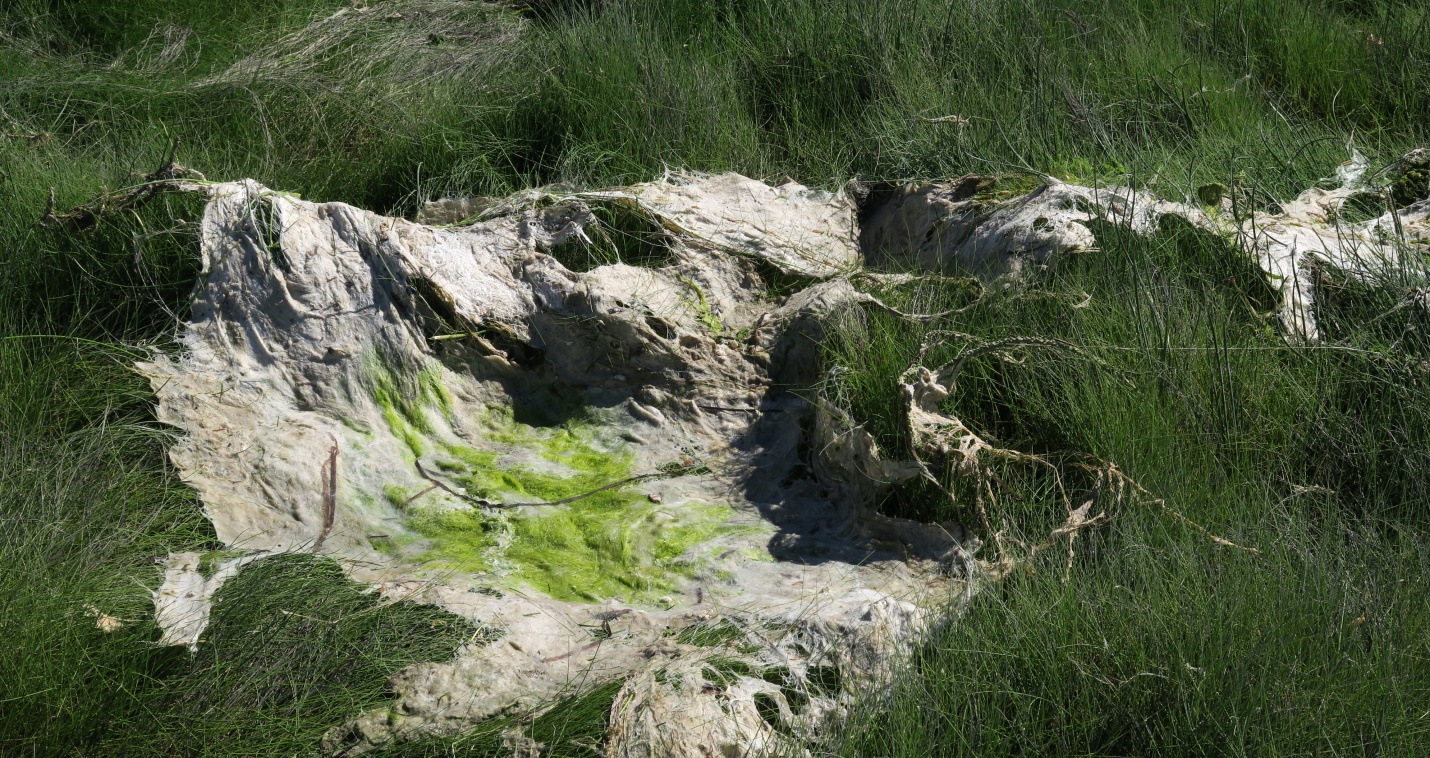
Figure 3: A very large mat of Ulva prolifera is ‘caught’ high up in the intertidal shoreline vegetation. As it dries, it fades from bright green to white and looks from a distance like a cast away tarp or discarded mass of litter. Comox Bay, Strait of Georgia, B.C., Canada. June 26, 2021. Photo ID 27377 ©Seaweedwhisperings.com
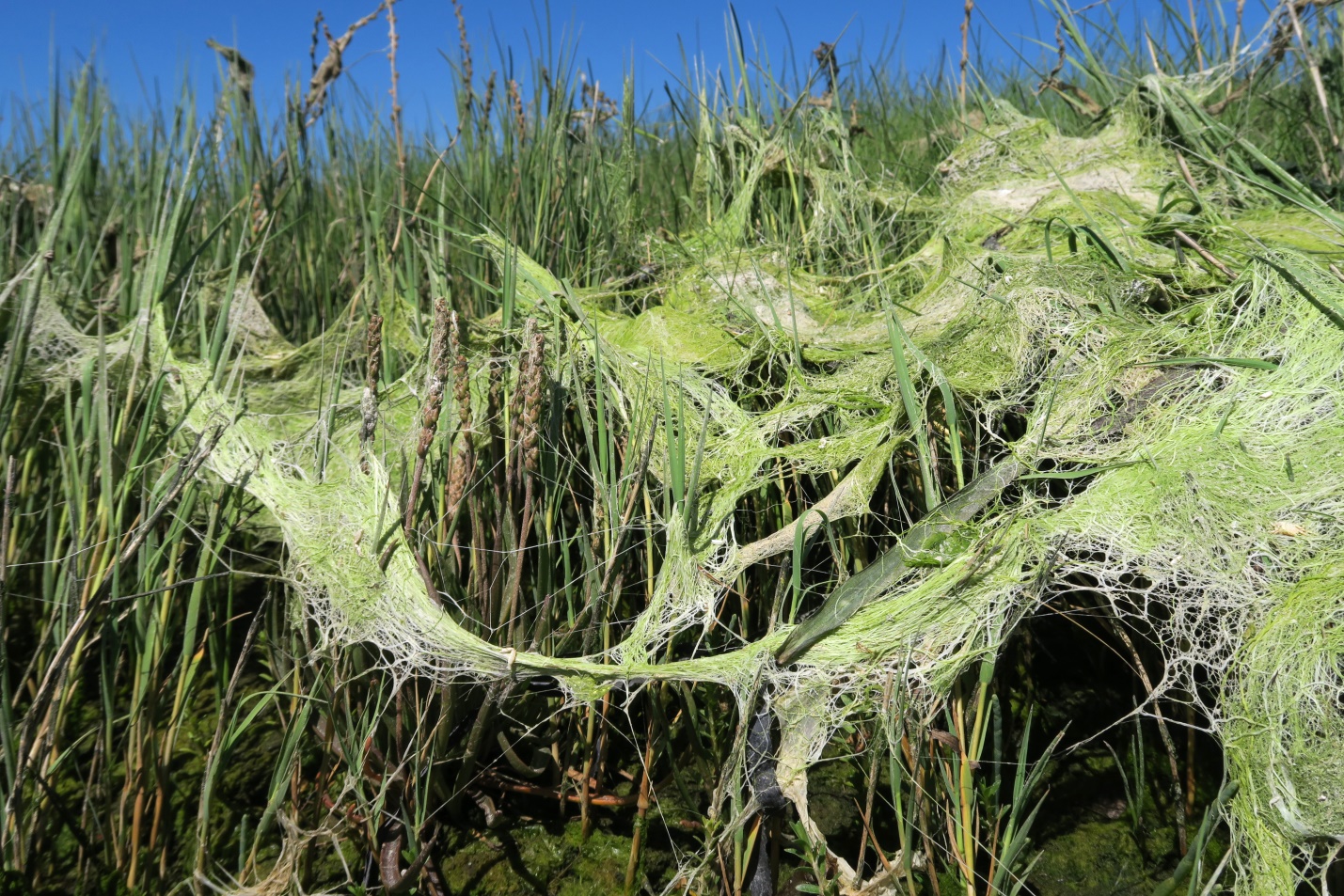
Figure 4: ‘Hammocks’ of algae or algae ‘spider webs’ – a view of some of the ways this multi-branched seaweed looks when displaced from its watery environment. Comox Bay, Strait of Georgia, B.C., Canada. June 26, 2021. Photo ID 27378 ©Seaweedwhisperings.com
Discussion:
Floating on a calm sea – this is bliss for Ulva prolifera. And in their floating state, they also are rudderless. They appear to wander aimlessly, at least physically. They can be stranded ashore and unintentionally smother other life or suffer injury themselves as well. Their only salvation is when the sea frees them, lifts them, and they can float free once again.
Indeed, structure in form or movement may be a kind of limitation that is a huge impediment to the preferred energy of this seaweed. So, where there may be direction to ‘the wanderings’ of this seaweed seems to be within..., there or else in a realm that is totally distinct and separate from the physical. Perhaps this is what lights them up glowing green with joy and perfect happiness. In a way, though, bliss can be another type of obliviousness, like the physical directionless-ness, it can exclude all else. This may be the ultimate challenge for Ulva prolifera..., how can they be “here” in this physical realm and also em-BODY their bliss, their boundlessness.
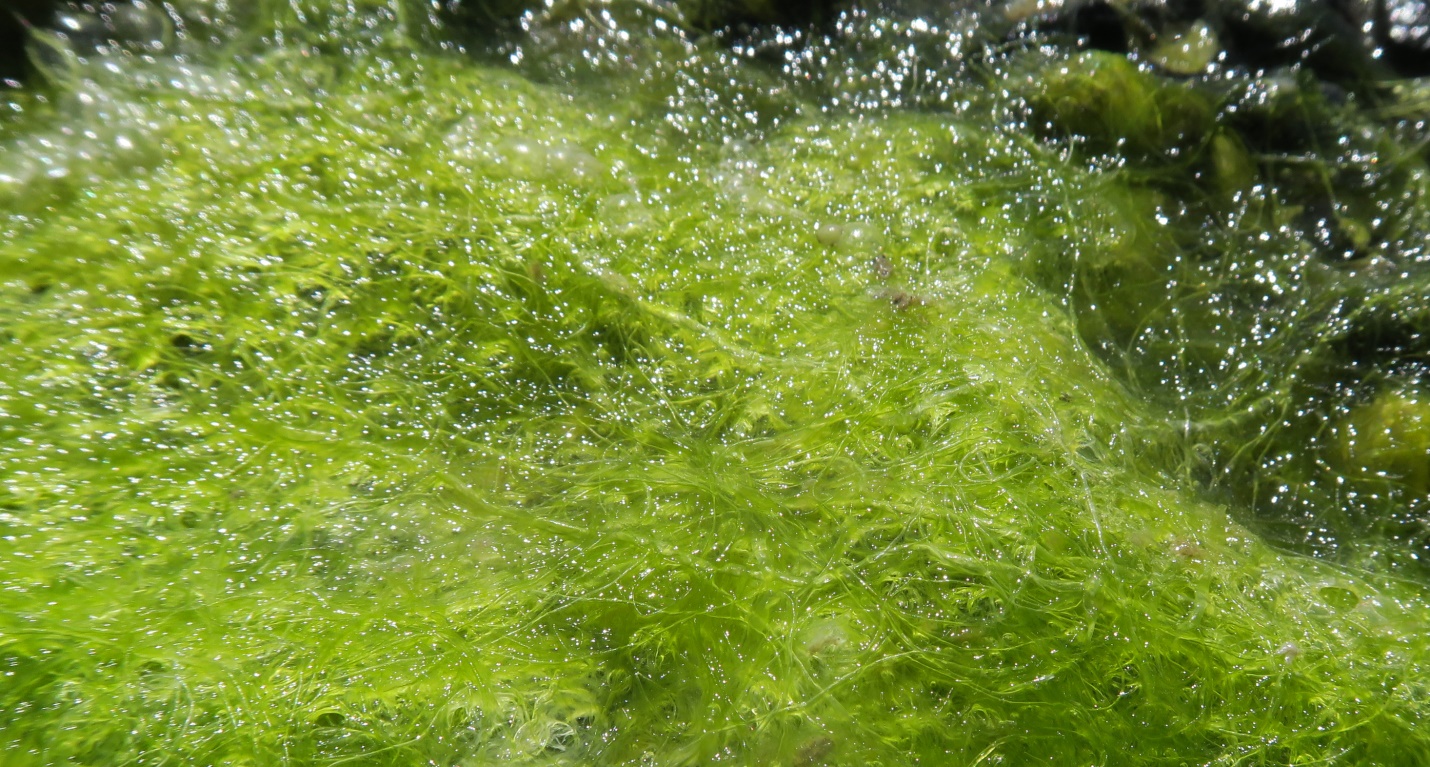
Figure 5: ‘Lit’ as from within like so many tiny neon tubes – Ulva prolifera is shown here as it rests in a shallow pool of ocean water. Comox Bay, Strait of Georgia, B.C., Canada. June 26, 2021. Photo ID 27379 ©Seaweedwhisperings.com
Biology & Natural History Information:
Description:
Thallus is tubular, although it can appear filamentous because of its narrow diameter. Individual tubes grow up to 50 cm in length. Holdfast is small, inconspicuous and disc-like. Few to many branches proliferate from the tube. It forms extensive mats several meters in length. The color can range from rich green to very light green.
Habitat:
This Ulva species can use a wide range of habitats and is commonly found on protected beaches attached to cobble or smaller substrates and also lives free-floating especially in muddy areas in summer.
North Pacific Distribution:
Arctic Ocean, Bering Sea and Aleutian Islands, Alaska, to Mexico; China; Korea; Japan; Russia.
Remarks:
Ulva prolifera is not only prolific in its growth habit; it is a species of Ulva that is documented as living worldwide. Much research is being conducted on current taxonomy so distribution details may be updated, but current understanding is that the cold water regions of the world’s oceans seem to all be suitable homes for this species.
Former name(s): Enteromorpha prolifera
Classification:
Phylum: Chlorophyta
Class: Ulvophyceae
Order: Ulvales
Family: Ulvaceae
Genus: Ulva
Species: Ulva prolifera O.F. Müller 1778
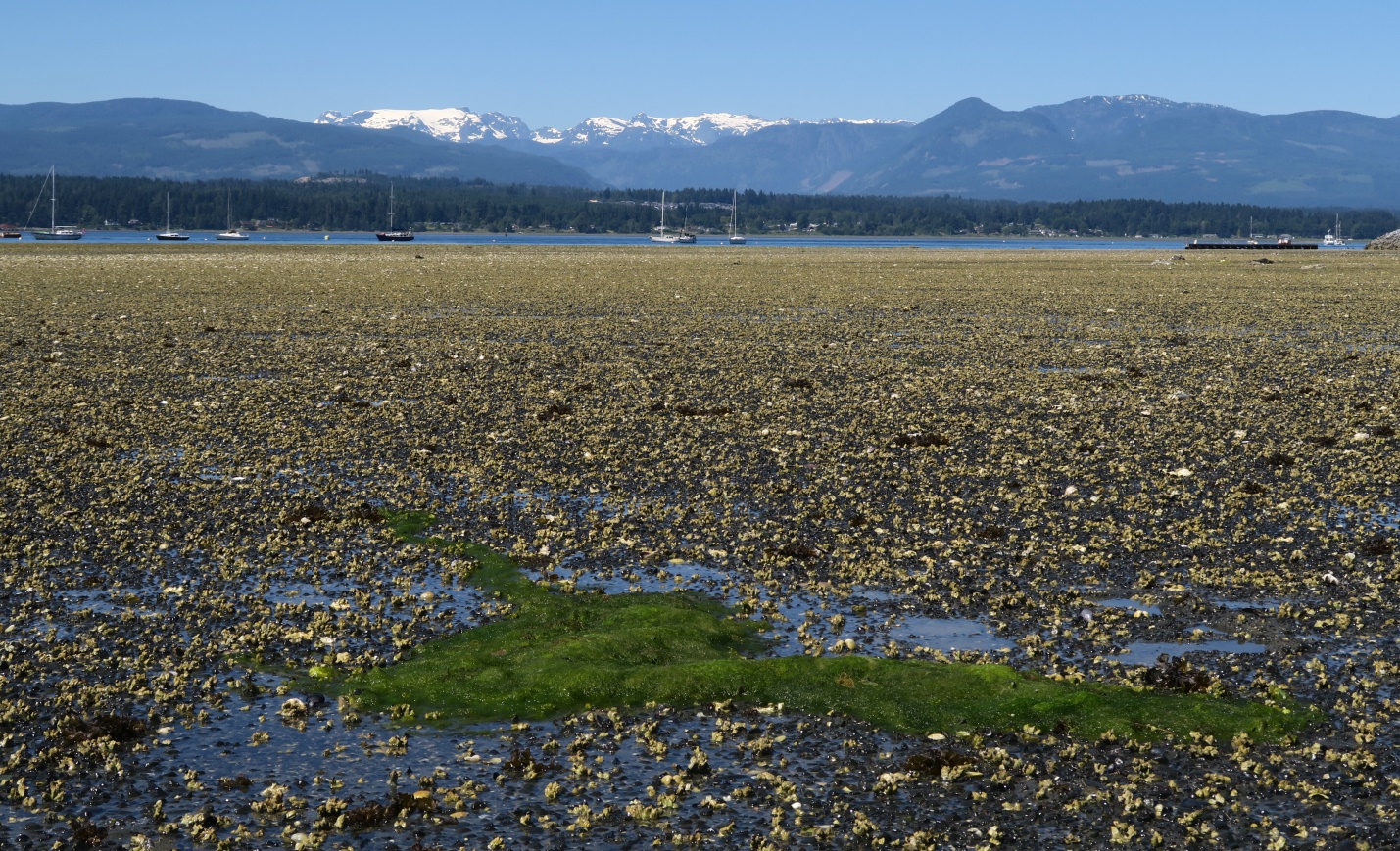
Figure 6: The large mat of green in the foreground is a 5 meter long patch of Ulva prolifera. In the long summer days it is not uncommon to encounter mats this size or even larger. Brooklyn Creek Estuary, Comox Bay, B.C., Canada. June 26, 2021. Photo ID 27380 ©Seaweedwhisperings.com
![]()